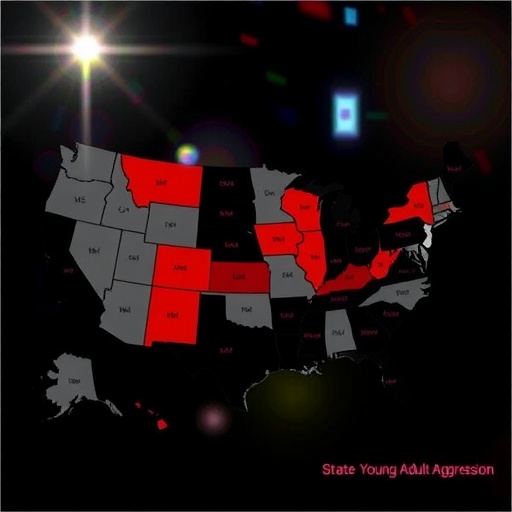State violence has long been a pervasive presence in societies around the world, influencing various socio-political dynamics. One of the most alarming facets of this phenomenon is its significant impact on interpersonal violence, particularly among young adults. As societies grapple with issues of state oppression, the ripple effects often manifest themselves in the behavior and relationships of the youth. A recent study by B. Aghayeeabianeh titled “The Impact of State Violence on Interpersonal Violence among Young Adults” addresses these complex interrelations, revealing how exposure to state-sanctioned aggression can lead to increased violence among peers.
The study provides ample evidence that young adults exposed to environments rife with state violence exhibit a marked increase in interpersonal aggression. The correlation delineates a troubling cycle in which state violence establishes norms of aggression and conflict resolution that individuals subsequently mimic in their personal relationships. This mimicking phenomenon, as suggested in the study, underscores an urgent need to assess the broader implications of state violence on how young adults learn to navigate their social worlds, particularly in terms of employing violence as a means to resolve conflict.
The findings presented by Aghayeeabianeh rely on a robust methodological framework that combines qualitative interviews and quantitative surveys distributed among diverse cohorts of young adults. This dual approach enables a richer understanding of the nuanced ways in which state violence seeps into interpersonal relationships. The data illustrate that during periods of civil unrest or heightened state surveillance, the youth not only become victims of state aggression but also internalize an adversarial disposition towards their peers, leading to escalated incidents of violence and aggression, both verbal and physical.
The implications of these findings are far-reaching. The normalization of violence within a community or society can have devastating effects over time. The study highlights that young adults who have regularly witnessed state violence are more likely to view aggression as an acceptable method of conflict resolution. This normalization process creates an alarming feedback loop, where the experience of state violence begets a culture of violence within peer groups, leading to further societal dysfunction.
As the study articulates, understanding the psychological and social dynamics that influence young adults’ perceptions of violence is crucial for developing effective interventions. Programs aimed at reducing interpersonal violence must contend not only with individual experiences but also with societal conditions that perpetuate cycles of violence. Addressing state violence requires an integrated approach that includes education, community building, and supportive interventions, which foreground empathy, understanding, and conflict resolution without resorting to aggression.
Furthermore, Aghayeeabianeh’s work emphasizes the role of social media in shaping perceptions of violence among young adults. The pervasive nature of digital communication has become a breeding ground for both the glorification of violence and the dissemination of state propaganda. These platforms often amplify narratives that justify state-sponsored violence, further embedding these norms in the psyche of the youth. The author argues that efforts to counteract this trend must be vigilant and proactive, aiming to replace destructive narratives with messages of resilience, peace, and constructive conflict resolution.
The research also delves into the role of peer influence and group dynamics in perpetuating the cycle of violence. Young adults are particularly susceptible to peer pressures, often mirroring the behaviors and attitudes of their social circles. Therefore, it is imperative to cultivate environments where non-violent norms are not only encouraged but celebrated. Sociologists and psychologists must collaborate to create analytical frameworks that explore how group identities and loyalties can either provoke or mitigate interpersonal violence, especially in contexts marked by state aggression.
This extensive examination reveals that addressing the consequences of state violence is not merely an issue of policy reform or government accountability. It demands an understanding of the cultural narratives and psychological implications that inform the behavior of young adults. Rethinking strategies to combat both state violence and interpersonal violence requires stakeholders to engage with the very fabric of social relationships and community identity.
As societies continue to witness waves of civil unrest and state aggression, the insights provided by Aghayeeabianeh become increasingly vital. It is crucial for scholars, policymakers, and community leaders to engage with this research to develop targeted interventions that not only address the immediate effects of state violence but also cultivate a culture of non-violence and empathy among young people.
In conclusion, the interplay between state violence and interpersonal aggression remains an urgent area of inquiry. With young adults positioned at the nexus of these realities, understanding the psychological and social implications of these experiences offers pathways towards healing and restoration. Aghayeeabianeh’s findings challenge us to rethink how we view violence, emphasizing that it is not an isolated phenomenon but rather one deeply intertwined with the broader socio-political landscape. As we push forward, the call to action is clear: we must strive to dismantle the cycles of violence and foster a generation that is empowered to resolve conflicts through understanding and dialogue rather than aggression.
Subject of Research: The Impact of State Violence on Interpersonal Violence among Young Adults
Article Title: The Impact of State Violence on Interpersonal Violence among Young Adults
Article References:
Aghayeeabianeh, B. The Impact of State Violence on Interpersonal Violence among Young Adults.
Journ Child Adol Trauma (2025). https://doi.org/10.1007/s40653-025-00731-z
Image Credits: AI Generated
DOI: 10.1007/s40653-025-00731-z
Keywords: State violence, interpersonal violence, young adults, psychological impact, social dynamics, community interventions.




